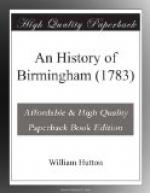The Butts; a mark to shoot at, when the bow was the fashionable instrument of war, which the artist of Birmingham knew well how to make, and to use.
Gosta Green (Goose-stead-Green) a name of great antiquity, now in decline; once a track of commons, circumscribed by the Stafford road, now Stafford-street, the roads to Lichfield and Coleshill, now Aston and Coleshill-streets, and extending to Duke-street, the boundary of the manor.
Perhaps, many ages after, it was converted into a farm, and was, within memory, possessed by a person of the name of Tanter, whence, Tanter-street.
Sometimes a street fluctuates between two names, as that of Catharine and Wittal, which at length terminated in favour of the former.
Thus the names of great George and great Charles stood candidates for one of the finest streets in Birmingham, which after a contest of two or three years, was carried in favour of the latter.
Others receive a name from the places to which they direct, as Worcester-street, Edgbaston-street, Dudley-street, Lichfield-street, Aston-street, Stafford-street, Coleshill-street, and Alcester-street.
A John Cooper, the same person who stands in the list of donors in St. Martin’s church, and who, I apprehend, lived about two hundred and fifty years ago, at the Talbot, now No. 20, in the High-street, left about four acres of land, between Steelhouse-lane, St. Paul’s chapel, and Walmer-lane, to make love-days for the people of Birmingham; hence, Love-day-croft.
Various sounds from the trowel upon the premises, in 1758, produced the name of Love-day-street (corrupted into Lovely-street.)
This croft is part of an estate under the care of Lench’s Trust; and, at the time of the bequest, was probably worth no more than ten shillings per annum.
At the top of Walmer-lane, which is the north east corner of this croft, stood about half a dozen old alms-houses, perhaps erected in the beginning of the seventeenth century, then at a considerable distance from the town. These were taken down in 1764, and the present alms-houses, which are thirty-six, erected near the spot, at the expence of the trust, to accommodate the same number of poor widows, who have each a small annual stipend, for the supply of coals.
This John Cooper, for some services rendered to the lord of the manor, obtained three privileges, That of regulating the goodness and price of beer, consequently he stands in the front of the whole liquid race of high tasters; that he should, whenever he pleased, beat a bull in the Bull-ring, whence arises the name; and, that he should be allowed interment in the south porch of St. Martin’s church. His memory ought to be transmitted with honor, to posterity, for promoting the harmony of his neighbourhood, but he ought to have been buried in a dunghill, for punishing an innocent animal.—His wife seems to have survived him, who also became a benefactress, is recorded in the same list, and their monument, in antique sculpture, is yet visible in the porch.




